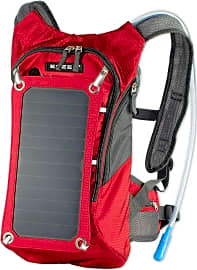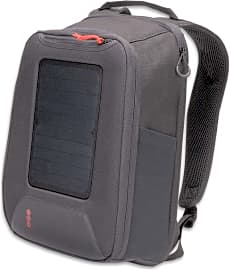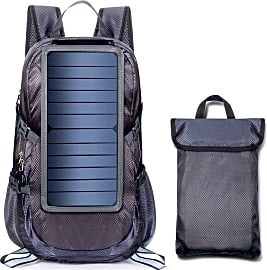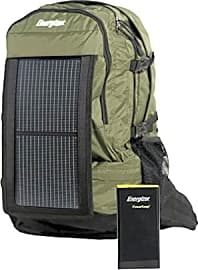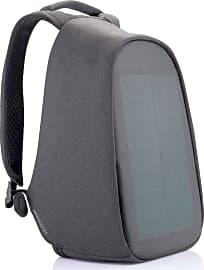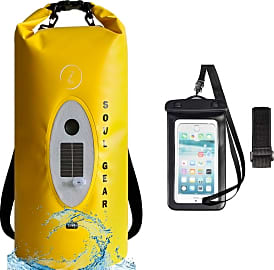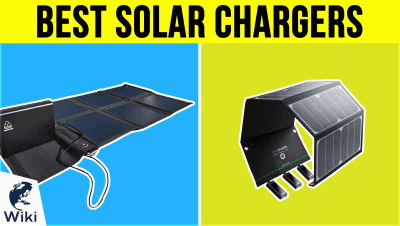The 10 Best Solar Backpacks

This wiki has been updated 39 times since it was first published in September of 2015. Instead of planning outings around the time and distance between power outlets, get a solar backpack to keep smartphones, tablets, laptops and music players charged up wherever the trail takes you. With a selection from our handy assortment of hiking, camping and commuter-friendly designs, you can do your bit for renewable energy and juice up those electronic devices while you're on the move. When users buy our independently chosen editorial picks, we may earn commissions to help fund the Wiki.
Editor's Notes
March 22, 2021:
It wound up being an extremely busy round of updates, in a fast-moving category that has seen more than its share of discontinuations and new entries during the past year. We removed the SunnyBag Iconic, due to availability issues, and almost took the same step with the Z ZTarx Soul Gear – a dry-bag backpack with a built-in Bluetooth speaker, which we thought, given its relatively reasonable price, might be particularly interesting to budgeted canoeists – but we wound up being able to source this option from an alternative vendor, and so it maintained its position close to the bottom of our list.
The PowerKeep Energizer Pro and Voltaic Systems OffGrid both lost their spots to upgraded models from their respective companies. The 30-liter PowerKeep Energizer Wanderer offers an average amount of storage, and its 10-amp-hour power bank (brought to you by that relentless pink bunny that’s known and trusted by so many) offers decent capacity, but it should be noted that its three-watt panel is significantly smaller than many models in the category. The 25-liter Voltaic Systems Array is 20% smaller than the Wanderer, but it still managed to clinch a top spot on our list with its two-year warranty, 10-watt panel and 24-amp-hour power bank. Its side pocket and bottom straps provide two means to transport a tripod, and a useful insert can be purchased from the company to offer further organization and effectively transform this unit to a camera backpack.
Other notable additions this time around include the Eceen Biker Pack — which features an integrated hydration bladder; the Eceen External Frame — which features a whopping 68-liter capacity, 20-watt panel and D-rings for carabiners, in case you want to hang it from a tree; and the Kingsons Beam — an anti-theft bag that also distinguishes itself by having one of the nicest designs in the category (if I may say so).
Backpacks like these can be a lot of fun, and are especially useful for things like hiking and day-trip adventures, but if you really want to furnish your campsite with some serious solar-powered luxuries, then you might be better heading over to our list of portable solar generators.
February 06, 2020:
While it seems like there are a ton of worthwhile solar backpacks out there, quite a few of them don't seem to be made well, from the backpack itself to the solar panel, regulator, and battery pack -- if a battery is even included. So we dug deep to figure out just which are worth your time and money. The Voltaic Systems OffGrid and Voltaic Systems Converter are two of the most popular, and while they're somewhat costly, we're comfortable with the reliability and long-term durability. The Energizer PowerKeep Pro is priced a bit better, and seems to hold up the Energizer name quite well. The SunnyBag Iconic is just a bit more expensive and is a large and convnient bag even before you consider its integrated solar panel. The same is true of the XD Design Bobby Tech, aside from the price -- it's extremely expensive but is also engineered and manufactured with the quality you'd expect from such a costly model.
There are a couple that are relatively affordable and happen to occupy somewhat specialty niches. The Eceen Daypack is remarkably lightweight and rolls up into one of its pockets, so it's great for taking along on a camping trip so you can tote your most useful gear around during day hikes and not worry about your phone, GPS, or camera battery dying. The Z ZTarx Soul Gear is essentially a high-tech roll-top waterproof bag, and although it's not recommended to fully submerge it in water, it should serve most aquatic purposes well.
If none of these are big enough for your purposes, there's always a DIY option available. If you pick up your own portable solar panel and battery bank, you can attach it as you see fit to a day hiking or internal frame backpack and you could end up with something notably more functional than a pre-built solar backpack, though you'll likely spend just as much, if not more.
Special Honors
Tespack If you like the idea of hauling around an onboard panel with your everyday-carry bag, but backpacks just aren't your thing, don't despair. Look for a messenger bag with a built-in panel, like the one offered by Tespack. This one in particular makes a nice pick for carry-on luggage, as you can remove it from the bag and it's the right size to be held over your airplane window. tespack.com
Voltaic Systems Array Camera Insert If you're a photographer who's thinking of picking up the Voltaic Systems Array, then you're definitely going to want to swing by their official website to checkout the bag's designated camera insert. While you're there, don't be afraid to look around; their array of cool, solar-powered gadgetry does extend beyond backpacks. voltaicsystems.com
Power In The Days To Come
These cells work like Velcro in a sense, as they each have a complimentary side to them, one negatively charged, the other positively charged.
Look to the horizon, and tell me if you don't read apocalyptic omens there. If you don't, you're not looking hard enough. Of course, the impending collapse of functioning society as we know it isn't the only reason for you to invest in a solar backpack, but it is the most exciting to talk about.
Sure, you might want to keep your camera and cell phone batteries charged when you're hiking in beautiful wildernesses, or be able to rely on a constant, free source of power when hopping around from country to country without a converter, but isn't it more thrilling to think that this backpack might someday not only be a convenient source of natural power, but also your only source of electricity?
Either way, the solar backpack is a life saver. By simply adhering a series of solar modules to the back and top areas of a simple backpack, these manufacturers have turned your carry-all into its own veritable power plant.
To understand how these packs work, it helps to understand how solar panels work. Essentially, a solar panel is comprised of a ton of little power pods called PV (photovoltaic) cells. These cells work like Velcro in a sense, as they each have a complimentary side to them, one negatively charged, the other positively charged.
The respective charges of each are the result of doping either side (both of which are silicon-based) with either boron or phosphorus. When boron and silicon combine there are holes left over by boron's deficiency in the valence electrons needed to form bonds to other substances. When phosphorus and silicon combine, the opposite is true, and an extra electron exists where the atoms meet. Thus, the boron-doped silicon carries a positive charge, where the phosphorus-doped silicon carries a negative charge.
In the space where the two sides meet, the extra electrons on the phosphorus side jump over to fill the holes in the boron side, creating an electrical field in the space between, called the depletion zone.
When a photon of light passes through a PV cell's depletion zone, it knocks an electron loose of its hole and either side will scramble to balance the depletion zone back out, ejecting the free-floating electron toward and along a metal wire, forming the electrical current.
How Far Will You Go?
Choosing a solar backpack may seem like an aesthetic decision at the outset, and it's true that you want a pack that you'll actually be willing to wear out in the sunlight. Otherwise, you might as well pick up a simple backpack without any of that glorious solar technology to it, and that would be a shame.
The smaller, lighter bags with just a panel and a plug will probably be enough for you.
Once you've narrowed down our list to a smaller number of stylishly pleasing packs, you can start to evaluate them based on their features, and the features that will be most important to you depend on the distances you plan to travel.
If you're going for longer stretches without access to reliable electricity, you'll want to focus on a pack that can produce more juice than its competition from less sunlight, and ideally one with an internal power reservoir for storage. These tend to be a little heavier than the charge-as-you-go style of bag, but they prove more useful in the long run.
You might just want to keep your phone charged while you're on the go in another country, though, just to make sure you have enough power to run any apps you need for navigating foreign soil. The smaller, lighter bags with just a panel and a plug will probably be enough for you.
Power Pulled From The Sun
While a French physicist named Edmund Bequerel first made note of a photoelectric effect in 1839, the first photovoltaic module as such wouldn't come into existence until Bell Laboratories built it in 1954. Of course, this was well after Albert Einstein won the Noble Prize in 1921 for his work on the photoelectric effect among other things.
In the public sector, you'll already have noticed the inclusion of solar arrays on street lamps and road signs, and that's just the beginning.
Those early modules made by Bell and others were small and pretty inefficient, with short lifespans and grotesque price tags, but they were necessary to the development of the much more durable, less expensive solar technology we use today. Another big boost in the development of solar technology came from NASA in the 1960s, who began using solar power on their spacecraft and satellites in earnest.
In recent years, the vast majority of research into solar electricity has been geared toward the consumer market, with companies offering to share in the investment to help offset initial costs to homeowners.
In the public sector, you'll already have noticed the inclusion of solar arrays on street lamps and road signs, and that's just the beginning. A small portion of America's iconic Route 66 roadway is getting a huge solar makeover, replacing its pavement with a special, experimental solar street which is designed to power nearby communities while directly melting ice on roadways and providing driver feedback about animal crossings, accidents, and more.




